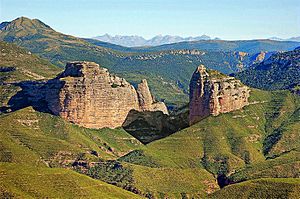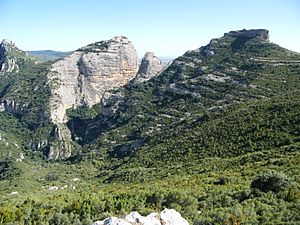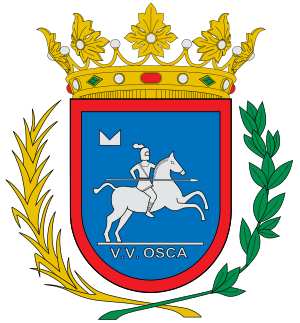Salto de Roldán facts for kids
Salto de Roldán means 'Roland's Leap' in English. It's a cool rock formation about 25 kilometers (15.5 miles) north of Huesca in northern Spain. You can find it in the foothills of the central Pyrenees mountains. This amazing place is part of the western side of the Sierra y Cañones de Guara Natural Park. It looks like huge, bare rocks sticking out of the ground around them.
Contents
Exploring Salto de Roldán
Salto de Roldán has two main rocky parts. The one on the west is called Peña San Miguel, which means 'St Michael's Rock'. It's about 1,126 meters (3,694 feet) high. The other one, to the east, is Peña Amán, which is around 1,121 meters (3,678 feet) tall. The sides of these rocks that face away from each other are sloped. But the sides that face each other are very steep, like giant steps! They rise about 250 to 300 meters (820 to 984 feet) above the land around them. The two peaks are about 700 meters (2,300 feet) apart.
There's also a smaller rock called El Fraile, or 'The Friar', which is about 1,036 meters (3,399 feet) high. It stands alone about 500 meters (1,640 feet) northeast of Peña San Miguel. The river Flumen flows between these rocks, from north to south.
These rocks are what's left of a U-shaped fold in the ground, made of layers of conglomerate limestone. This type of rock was formed a very long time ago. In northern Spain, these rock formations are called mallo. Salto de Roldán was created in two main steps. First, an old river cut a wide, deep canyon through the rock. Then, the Flumen river cut an even deeper, narrower gorge inside that canyon. This gorge is called Palomeras del Flumen.
A French explorer named Lucien Briet visited Salto de Roldán in 1907. He was really impressed by the view! He thought it looked like a temple for an ancient god, maybe Hercules. He even said that the famous artist Gustave Doré should have used this landscape for his drawings in Dante's Inferno instead of just imagining them. Briet believed that the Christian church built on Peña de San Miguel was probably built on the spot of an even older temple.
Salto de Roldán is a popular place to visit. You can walk to it from a nearby road. If you're brave, you can even climb to the top of Peña San Miguel! But be warned, you'll need to use two ladders made of metal steps stuck into the rock. At the top, you can see the old ruins of a castle, a water tank, and a small church from the Middle Ages. The view from up there is truly amazing!
Plants and Animals at Salto de Roldán
Around Salto de Roldán, you can find many interesting plants. There are pretty flowers like the Pyrenean-violet and corona de rey. You might also see aromatic herbs like rosemary and thyme. Trees like box and kermes oak grow here too. And keep an eye out for different kinds of orchids, including the yellow-fringed orchid.
This area is also home to a wide variety of birds. You can spot birds that eat insects, like the black redstart and African stonechat. There are also fast-flying birds like swifts and crag martins. Smaller birds like goldfinches and robins are common too.
But the most exciting birds to see are the birds of prey! You might see huge griffon vultures and Egyptian vultures soaring high above. There are also different types of eagles, such as the short-toed eagle, booted eagle, golden eagle, and Bonelli's eagle. You might even spot a peregrine falcon or a kestrel. A very rare visitor is the bearded vulture, also known as a lammergeier. These large birds use the warm air currents above the rocks to fly high and look for food. The bearded vulture is special because it drops large animal bones onto the rocks to break them open so it can eat the marrow inside!
A Look Back: History of Salto de Roldán
People lived near Salto de Roldán a very long time ago, even before recorded history. Near the village of Santa Eulalia de la Peña, there's a cave called La Raja. Inside, you can find ancient cave paintings of people and animals like cows, deer, and goats. Experts think these paintings are some of the most western examples of this type of art. It's thought that early humans used to set up hunting camps near Salto de Roldán in the summer. Also nearby, there's a dolmen, which is an ancient stone tomb, at Belsué.
Later, the Romans had a settlement close to the modern village of Apiés. We also know that the Visigoths were here, thanks to a belt plate found in the village of Sabayés. After the Muslims took over Spain, Huesca became part of their land, and Salto de Roldán was made into a strong fortress. It was a very important place because it controlled the way to the valley and plains of the River Ebro to the south.
In 941, a Christian leader named García Sánchez I of Pamplona captured the Fortress of Sen. But the next year, a Muslim lord from Zaragoza took it back. This victory was even celebrated in the Great Mosque of Córdoba! Finally, in 1086, Christian forces captured the fortress for good and kept it.
Amazing Legends of Salto de Roldán
Many exciting stories and legends are connected to Salto de Roldán.
The most famous legend is about Roland, a brave knight who was one of Charlemagne's best warriors. The story says that Roland was being chased by Saracens (Muslim soldiers) and found himself trapped at Salto de Roldán. To escape, he made an incredible leap on his horse from one rock to the other! There are different versions of the story: some say he leaped from Peña de Amán to Peña de San Miguel, others say the opposite. In some tales, his horse landed so hard that it left hoof prints in the rock! Sometimes the horse died from the leap, or it was even killed in mid-air by a sorcerer. Some stories say Roland then continued north on foot and hit the Pyrenees mountains with his sword, creating a gap called Roland's Breach, so he could see France one last time before he died.
(Historically, Roland actually died in 778 at the Battle of Roncesvalles, which was about 110 kilometers (68 miles) northwest of here. That battle and Roland became famous in other old legends.)
There are other legends that don't involve Roland at all. One story says that St Martin leaped from one of the rocks to a nearby church to escape being caught. In another, St Martin and St Michael were on top of Peña de San Miguel. St Martin was on a horse, and St Michael was on an ox. Only St Martin could make the leap, which is why the rock is named after St Michael, who had to stay behind. Another legend tells of the Devil himself, riding a fiery horse, jumping across the gap. There's even a legend about a giant spider that sat between the rocks and spun its silk down into the deep space below.
In more recent times, people said that Salto de Roldán was a meeting place for witches called almetas. They would fly to Peña de San Miguel on winter nights, especially Fridays or Easter Day, to plan their mischief. Men would try to shoot them out of the air using shotguns loaded with wax pellets that had been blessed by a priest. In another legend, Patetas (a local name for the Devil) would pass by on stormy nights, leaving smoking footprints behind him.
Both the modern Coat of Arms of Huesca (from the 16th century) and its older version (from the 13th century) show a block with a V-shaped notch at the top. Many people believe this symbol represents Salto de Roldán. Some writers have even suggested that the official Spanish name of Huesca, Osca, comes from an old word meaning 'notch' or 'indentation', referring to Salto de Roldán.
See also
 In Spanish: Salto de Roldán para niños
In Spanish: Salto de Roldán para niños




